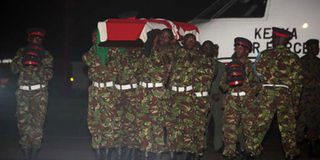Shabaab kills dozens of Kenyan troops in Somalia; here is what it all means

Soldiers at Wilson Airport carry the four bodies soon after being offloaded from a Kenya Air Force plane on January 18, 2016. Since 2009, the African Union peacekeepers has suffered at least 1,234 casualties. The conflict has directly killed at least 500,000 Somalis since 1991. PHOTO |EVANS HABIL | NATION MEDIA GROUP
What you need to know:
- The militants claim that they killed 100 Kenyan soldiers in the Friday morning attack in Somalia.
- It said there was a company of Kenyan soldiers at the El-Adde base. A company typically consists of 80 to 250 soldiers.
- Since 2009, the African Union peacekeepers has suffered at least 1,234 casualties.
- And it’s also worth noting that conflict has directly resulted in the death of over 500,000 ordinary Somalis since 1991.
The attack on Kenya’s soldiers in Somalia by Al-Qaeda linked terror group Al-Shabaab has galvanised the country behind the military.
The militants claim that they killed 100 Kenyan soldiers in the Friday morning attack on an African Union peacekeeping force base in El-Adde, southern Somalia.
Shabaab, which often exaggerates the casualties it inflicts on the peacekeeping force, known as Amisom, also claimed to have taken 12 soldiers prisoner. It had at first claimed to have killed 63.
While acknowledging the attack, Kenya has not confirmed the casualties, saying it needed to first inform the families of the soldiers, and to carry out further verifications.
However, it said there was a company of Kenyan soldiers at the El-Adde base. A company typically consists of 80 to 250 soldiers.
Some context is important here, because believe me, going by comments one sees online, there are still people who don’t know that the Kenyan forces are in Somalia as part of Amisom.
And for these residents of the Moon, the other troop contributing countries in Amisom are Uganda, Burundi, Ethiopia, and Djibouti.
Sierra Leone, too, had peacekeepers troops, but withdrew its battalion early in 2015.
That little background is critical to appreciating the bigger meaning of what happened to the Kenya peacekeepers.
AMISOM CASUALTIES
The Kenyan casualties were the first for Amisom in 2016, and brought the total losses for the African Union peacekeepers since 2009 to at least 1,234 – a figure that combines the best estimates of the African troops casualties from 2009 to 2014 reported by the rather dependable Stockholm International Peace Research Institute (SIPRI), and the numbers available for 2015, for which there is a meticulous listing in Wikipedia. This excludes the casualties from 2007 to 2009.
So while Kenyans are understandably shocked and agitated over the deaths of their soldiers, if one steps back and looks at them against the wider canvas of the total Amisom casualties, we see a nuanced story.
The total Amisom deaths highlight the price that the African countries contributing troops have so far paid to end the long-drawn in Somalia.
And it’s also worth noting that conflict has directly resulted in the death of over 500,000 ordinary Somalis since 1991.
To get a sense of what the death of 1,234 — or indeed 63 or 100 — peacekeepers means, we need not go further than the events that led to the US withdrawal from Somalia in 1994.
BLACK HAWK DOWN
The US sent troops in December 1992 in a largely humanitarian operation code-named “Operation Restore Hope”, but quickly got drawn militarily in the Somalia conflict.
On October 3, 1993, a team of US special forces was sent to central Mogadishu to arrest two senior commanders of the warlord Mohammed Aideed, who was the de facto ruler over the city.
What was supposed to be a quick grab turned into a drawn-out battle after Aideed militia men shot down an American Black Hawk helicopter.
The “Battle of Mogadishu”, as it came to be known, was told in the very popular 2001 film “Black Hawk Down”.
The US lost 19 soldiers in the Battle of Mogadishu, and up to 1,000 Somali militia and civilians were killed.
Those 19 deaths were too much, and US withdrew from Somalia, with little accomplished, in March 1994.
The latest death of Kenyan troops in Somalia, and those of other Amisom troop contributing countries, should therefore be seen as a sharp edge of what the “African solution to African problems” means.
Many Africans get worked up when, especially, the west sticks its nose in the continent’s affairs.
They tell them to bugger off, and leave them alone to devise “African solutions to Africa's’ problems”. But to many of them, these are just slogans.
Some of the people for whom it’s not a slogan are the AU peacekeeping soldiers in Somalia. That mission, by the way, is also the AU’s largest.
The US, the world’s leading superpower, was in Somalia for nearly one-and-a-half months and, well, fled.
Amisom has endured it for nine years, nearly five times longer, and taken at least 65 times more casualties.
I am one of those who believe that other countries have a right to meddle in another that is messing up. The only question is “how”?
So Kenya can rightly argue that it has paid the highest price and is perfectly entitled to a say in the Somali settlement.
The author is editor of Mail & Guardian Africa. Twitter@cobbo3





